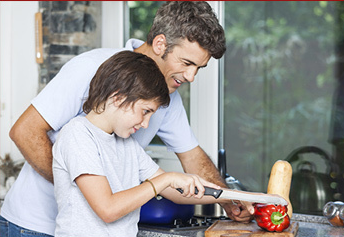
Instead of frying foods – which adds unnecessary fats and calories – use cooking methods that add little or no fat, like these:
- Stir-frying. Use a wok to cook vegetables, poultry or seafood in vegetable stock, wine or a small amount of oil. Avoid high-sodium (salt) seasonings like teriyaki and soy sauce.
- Roasting. Use a rack in the pan so the meat or poultry doesn’t sit in its own fat drippings. Instead of basting with pan drippings, use fat-free liquids like wine, tomato juice or lemon juice. When making gravy from the drippings, chill first then use a gravy strainer or skim ladle to remove the fat.
- Grilling and broiling. Use a rack so the fat drips away from the food.
- Baking. Bake foods in covered cookware with a little extra liquid.
- Poaching. Cook chicken or fish by immersing it in simmering liquid.
- Sautéing. Use a pan made with nonstick metal or a coated, nonstick surface, so you will need to use little or no oil when cooking. Use a nonstick vegetable spray to brown or sauté foods; or, as an alternative, use a small amount of broth or wine, or a tiny bit of vegetable oil rubbed onto the pan with a paper towel.
- Steaming. Steam vegetables in a basket over simmering water. They’ll retain more flavors and won’t need any salt.
